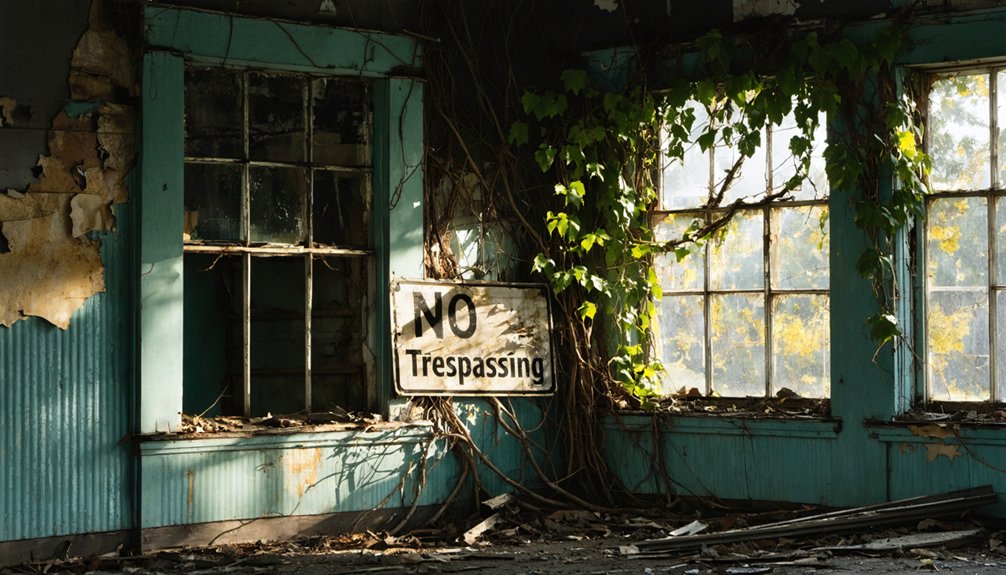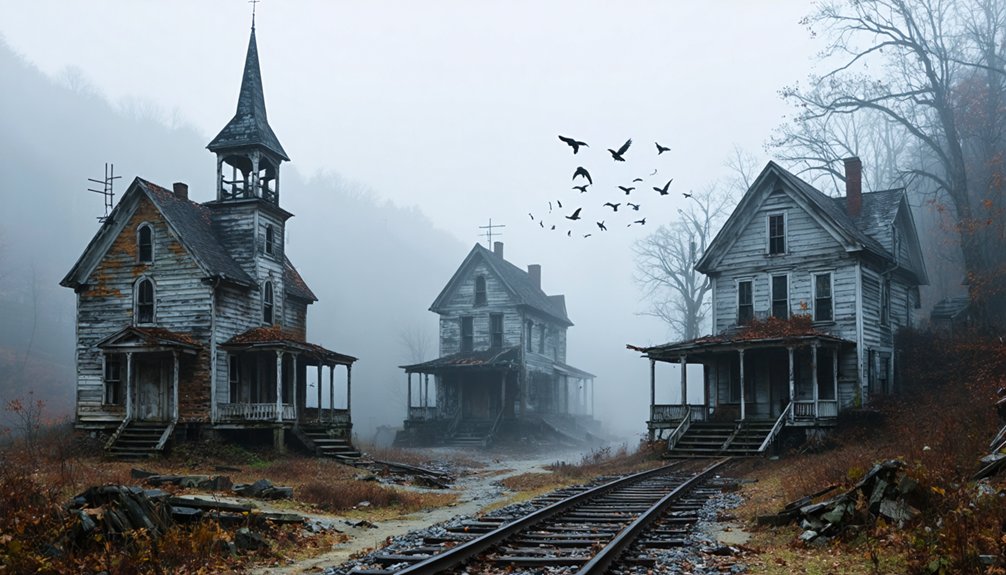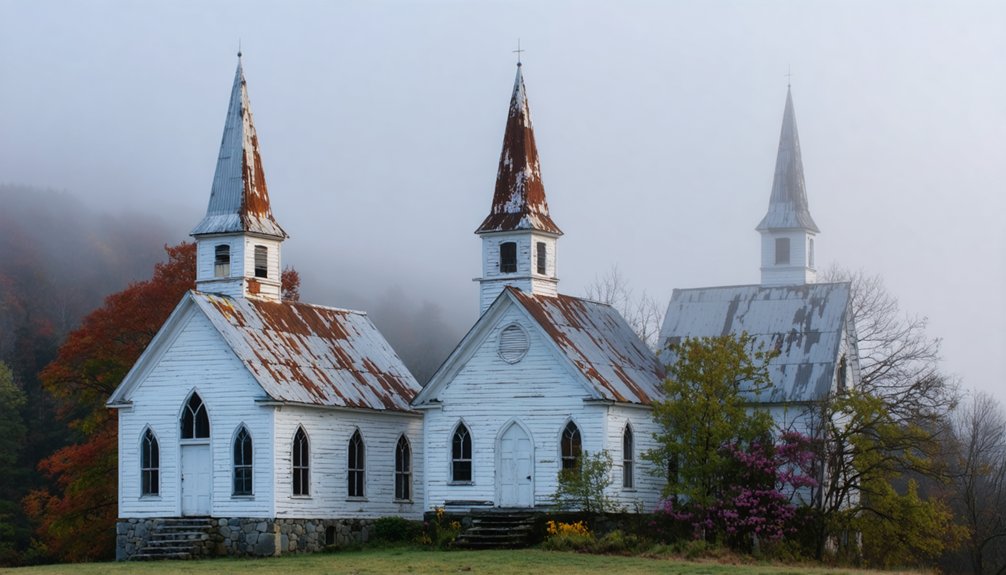Appalachian ghost towns face five critical preservation challenges: nature’s aggressive reclamation, with flora overtaking structures; severe funding inequities, with rural areas receiving only $93 per capita versus $1,013 in urban regions; vanishing cultural knowledge as knowledge-bearers relocate; community diaspora reducing local champions; and tension between authentic preservation and tourism development. These interconnected threats require coordinated responses spanning ecological management, equitable funding, documentation initiatives, community engagement, and sustainable tourism planning.
Key Takeaways
- Aggressive ecological succession accelerates structural decay as native flora overtakes abandoned buildings and mining sites.
- Systemic funding inequities limit preservation with Appalachian communities receiving only $93 per capita versus $1,013 in urban areas.
- Outmigration and aging populations diminish local champions and volunteer networks essential for sustaining preservation initiatives.
- Environmental hazards restrict physical access to historically significant sites that anchor community narratives.
- Tourism development creates tension between economic viability and maintaining authentic historical integrity.
Nature’s Relentless Reclamation of Historic Sites
While Appalachian ghost towns stand as evidence to bygone industrial eras, they face an existential threat from nature’s relentless reclamation processes.
You’ll observe native flora systematically overtaking abandoned structures as vines, trees, and undergrowth infiltrate buildings and paved areas, accelerating structural decay. This ecological succession manifests through cracked pavements, collapsing roofs, and eroded foundations. Research shows that reclaimed mining areas can eventually support up to 25 different tree species naturally recolonizing these sites.
The environmental legacy of mining compounds these preservation challenges. Disrupted waterways and altered topography increase runoff, while compacted, chemically altered soils prevent natural hydrologic functions.
Despite these destructive aspects, nature’s reclamation offers ecological benefits—reforestation sequesters carbon, improves water quality, and restores habitats. However, this process remains uneven and slow, creating a complex tension between historical preservation and environmental recovery in these forgotten industrial landscapes.
The Funding Gap: When Preservation Dreams Meet Financial Reality
Beyond the physical challenges posed by environmental reclamation, Appalachian ghost towns face a stark financial reality that frequently determines their ultimate fate.
The historic preservation funding landscape reveals profound structural inequities, with Appalachia receiving merely $93 per capita in philanthropic grants compared to urban areas’ $1,013. HPF limitations compound this disparity through prohibitive 40% matching requirements that economically distressed communities can’t meet.
Despite $1.84 billion in HPF appropriations since 2001, inflation and competing priorities diminish real impact. Your grant accessibility is further constrained by administrative burdens and competition with higher-profile projects. The situation is especially dire in the 30 Appalachian counties that have no active foundation, severely limiting access to local philanthropic support.
Effective funding strategies must overcome these systemic barriers while addressing the paradox that communities most needing preservation resources possess the least capacity to secure them. This financial chasm between preservation aspirations and economic reality continues to widen.
Disappearing Stories: The Race to Document Vanishing Heritage
As Appalachia’s ghost towns succumb to accelerating physical deterioration, an equally urgent crisis unfolds in the domain of cultural memory. The evacuation of knowledge-bearers through outmigration creates an imminent threat to oral tradition, requiring immediate intervention for narrative preservation.
You’re witnessing the fragmentation of cultural continuity as younger generations disconnect from their heritage.
- Digital archives struggle with accessibility barriers for disabled and linguistically diverse communities
- Limited institutional support hampers methodical documentation of marginalized experiences
- Environmental hazards restrict safe access to physical sites that anchor oral narratives
- Community mistrust constrains participation in formal documentation efforts
The remnants of once-thriving towns like Thurmond and Kaymoor represent crucial pieces of history that continue to fade with each passing season.
David Butcher’s initiative to establish a living museum in 2003 demonstrates the vital importance of local leadership in safeguarding Appalachian cultural artifacts.
This complex intersection of human dispersal and material decay necessitates innovative community-driven approaches to prevent irretrievable loss of Appalachian heritage.
Without intervention, these disappearing stories will vanish permanently from our collective understanding.
Community Diaspora and the Loss of Local Preservation Champions
The demographic hemorrhaging from Appalachian communities represents perhaps the most fundamental threat to ghost town preservation efforts. As populations decline by 10-25% over three decades, the critical mass needed for community engagement dissolves.
Preservation strategies falter without local champions to implement them. This diaspora creates a threefold crisis: diminishing volunteer networks, evaporating oral histories, and fragmented community identity. The abandoned structures of Elkmont, once vibrant with set-off houses that could be relocated, now stand as silent testimonials to this loss.
Leadership roles remain unfilled as younger generations relocate to urban centers, leaving aging populations unable to sustain preservation initiatives. The absence of local advocates means fewer grant applications, reduced fundraising, and abandoned restoration projects. The Little River Railroad that once facilitated Elkmont’s growth now exists primarily in historical archives rather than public memory.
The consequences extend beyond physical deterioration. When community memory fades and connections between generations weaken, the emotional investment necessary for preservation dissipates.
Without this collective will, even well-documented sites risk falling into permanent obscurity.
Balancing Authenticity With Tourism Development
When ghost towns shift from abandoned relics to tourist destinations, they encounter the fundamental tension between preservation and economic viability.
You’ll find authenticity remains the primary attraction drawing visitors to these historic sites, yet economic pressures often push toward cultural commodification.
Tourism sustainability depends on maintaining the delicate balance between development and preservation.
- Local community involvement enhances perceived authenticity while mitigating risks of historical distortion
- Adaptive reuse projects must carefully integrate modern amenities without compromising historical integrity
- Infrastructure improvements require strategic implementation that respects the original landscape
- Collaborative stakeholder partnerships facilitate more nuanced approaches to preservation challenges
The paradox remains: the very qualities that attract visitors—remoteness, historical integrity, and cultural uniqueness—are most vulnerable to degradation through tourism development itself.
The very essence that draws tourists to ghost towns risks being destroyed by their presence.
Successful preservation efforts acknowledge this tension rather than attempting to resolve it completely. Harlan County’s impressive 14% tourism growth demonstrates the economic potential when historical preservation is prioritized.
Frequently Asked Questions
How Do Paranormal Beliefs Impact Ghost Town Preservation Efforts?
Paranormal beliefs generate revenue through paranormal tourism, providing essential funding while challenging historical integrity. You’ll notice they enhance community engagement but create tension between authenticity and supernatural narratives in preservation work.
Can Virtual Reality Technology Preserve Ghost Towns Without Physical Restoration?
Virtual reality can create extensive virtual heritage documentation while offering immersive experiences of ghost towns, though you’ll find it complements rather than replaces physical conservation efforts necessary for complete historical preservation.
What Legal Liabilities Exist When Preserving Hazardous Historical Mining Structures?
Powerful preservation perils persist when you’re responsible for hazardous historic mining structures. You’ll face environmental liability concerns under CERCLA, negligence claims for structural failures, and safety regulations requiring mitigation without compromising authenticity.
How Do Preservation Priorities Differ Across Appalachian States?
You’ll notice priorities differ considerably: Virginia emphasizes adaptive reuse; West Virginia focuses on tourism infrastructure; while Tennessee prioritizes complete restoration. Regional funding availability and community engagement requirements vary considerably across state preservation frameworks.
When Is It Appropriate to Let a Ghost Town Naturally Decay?
Time marches on when preservation ethics justify letting limited resources go elsewhere, when communities prefer natural decay, when environmental impact favors non-intervention, or when sites lack historical significance or documentation.
References
- https://appalachianmemories.org/2025/10/16/the-lost-towns-of-appalachia-the-forgotten-mountain-communities/
- https://repository.essex.ac.uk/20823/1/McClanahan
- https://gatlinburghaunts.com/elkmont-tennessees-ghost-town/
- https://files.eric.ed.gov/fulltext/ED443642.pdf
- https://www.ohio.edu/news/2025/11/tablertown-reclaims-its-name-how-voinovich-school-partnering-invigorate-abandoned
- https://www.arc.gov/wp-content/uploads/2021/02/ARC-Tourism-report-final-Dec-2020-1.pdf
- https://kb.osu.edu/server/api/core/bitstreams/91be584d-7645-41ab-8c35-b676ebeb89da/content
- https://files.eric.ed.gov/fulltext/ED076297.pdf
- https://appvoices.org/2021/03/05/opportunities-reclaim-aml/
- https://www.wkms.org/environment/2022-05-09/abandoned-mine-lands-restoration-brings-excitement-but-long-term-challenges-remain-for-mountain-communities



